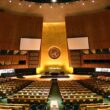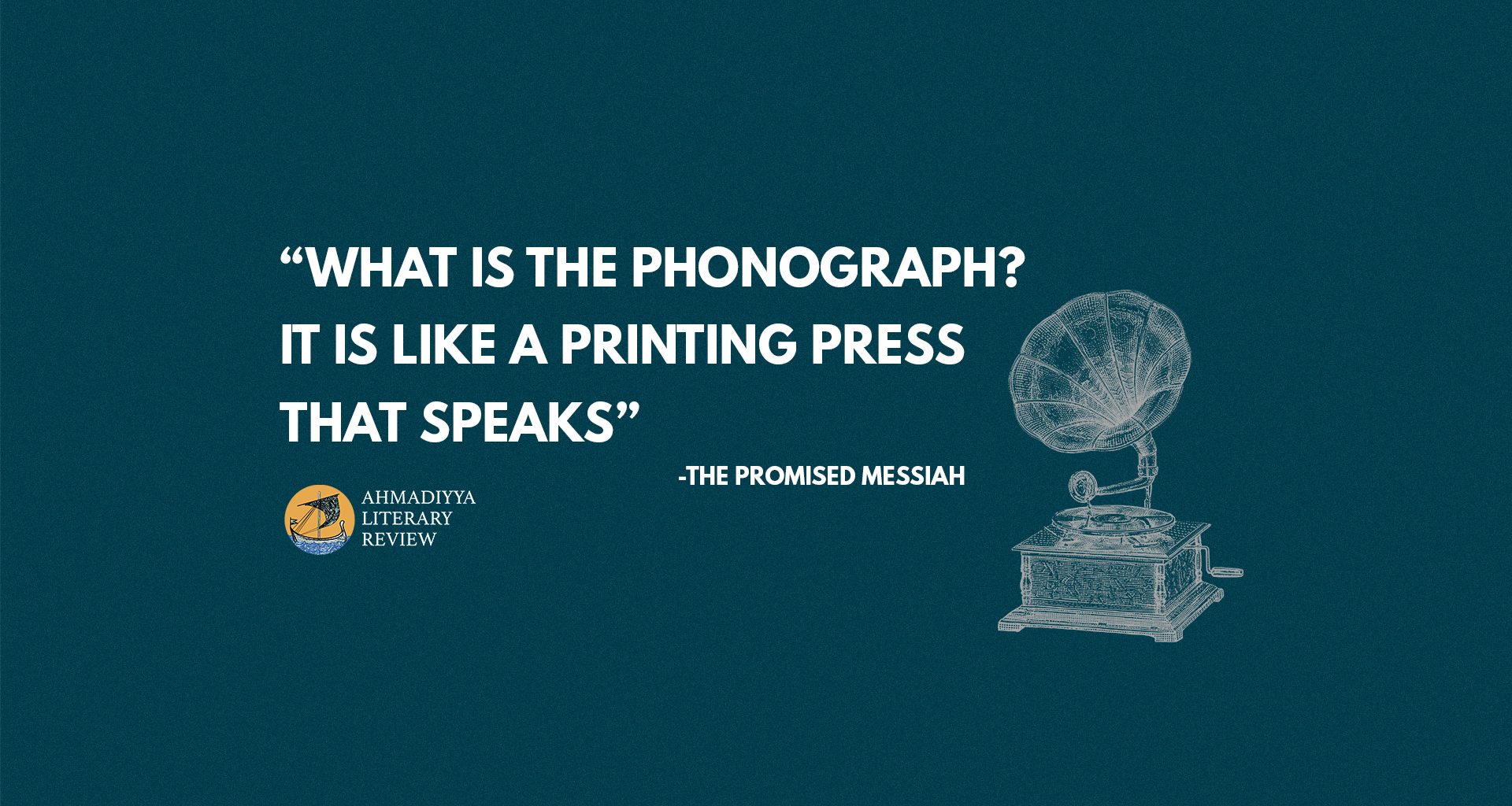Once someone objected to the Promised Messiah (as) telling his Community that God had promised him that, without any vaccination, he would be saved from the plague. He replied “Tools and means have been created for the friends of God”—new technologies had been created to serve his cause.
The Ahmadiyya Muslim Community, under the leadership of the Promised Messiahas and subsequently, the Caliphs, has never shied away from using technology. This is something that becomes quite clear when we reflect upon our history—the Promised Messiahas held the belief, and continuously explained through writing and speeches, that the inventions of his age were caused by God Almighty to further his mission: since it was a time of disorder unlike anything that had been witnessed in the past, the reformer of the age needed such tools that too had never been seen before. Moreover, if God Almighty had promised “I shall cause thy message to reach the corners of the earth” it was God Almighty who would create the means for such global propagation to occur.
The manner in which newer ways of conducting the affairs of the Jama’at have come to light during the pandemic strengthen this belief. Though we could not meet in person, we could convene virtually; though we Talim classes could not take place at the local mosque, a half-an-hour booking on Zoom was all that was needed; though events could not take place at a particular location, they could be live-streamed from any living-room in the world; most importantly, though people from around the world could not visit Hazrat Khalifatul-Masih Vaba, the image and voice of Huzoor was able to travel to distant lands. In a way the pandemic enhanced and accelerated the way the Jama’at uses technology: more articles were published; communications were enhanced, and new websites were launched. The work of the Ahmadiyya Muslim Community, by God’s grace, did not stop.
Thus is the history of the Ahmadiyya Muslim Community: we find such technologies and inventions keenly and enthusiastically being used by the Promised Messiahas and the Caliphs of the Jama’at to further the cause of Islam. In 1901 the Promised Messiahas stated: “God Almighty has gathered all the means of tabligh. Hence, through the creation of the press, the increase in paper, the postal system, the telegram, the rail and steam-powered ships, the entire world has become like a city. Furthermore, newer and newer inventions are increasing this togetherness as the means of tabligh are being brought together. We can use the Phonograph for tabligh – and an amazing means it is! – [added to this is] the establishment of newspapers and magazines, in short, such means of tabligh have been brought together that it’s like cannot be found in any previous age.”[i]
The Promised Messiahas after listing modern day inventions being a fulfilment of a Quranic prophecy wrote:
“This is the act of God Almighty, so that He aids us in our endeavour and so that He causes our religion and books to spread, and so that He causes our verities to reach every nation, so that they hearken and become guided[ii].” And this is what is astonishing. The world around us, with all its technology, has been created so that it may be easier for us to do tabligh—something of a recurring theme in the writings of the Promised Messiahas, especially at the discussion of some new invention. It was around his lifetime that the phonograph had been invented. It is difficult for us to imagine a world without these technologies that we find ourselves immersed in today, as such it also becomes difficult to measure how amazed people were when they first came into contact with a machine that recorded sounds and voices and played them back perfectly—it almost had a magical feel to it and such was it’s effect. Mix this magical aura to the mesmerising words of a prophet and you will get the way the phonograph was used by the Promised Messiahas. In fact, when the phonography was brought to Qadian at the Promised Messiah’sas request, a local Hindu sent a direct request to the Promised Messiahas expressing his desire to see this invention. The Phonograph had been brought to Qadian so that deliberations could take place on how to use it for the purpose of Tabligh. The Promised Messiahas had stated that when a group goes for tabligh “we should record a speech of ours in Arabic that is four hours long in which our claims and arguments have been discussed. The benefit of this will be that wherever they go, they should make others hear this speech. Through this tabligh will be conducted and it will be as if I am speaking…Till now, the phonograph has been used as a plaything only, but in reality, God had kept this invention for us, and a great task shall be discharged through it![iii]”
As planned, when this phonograph was brough to Qadian at the request of the Promised Messiahas in 1901, deliberations as to how it could be used for tabligh did indeed take place. It was suggested that Hazrat Molvi Abdul Karim Sialkotira should record a preliminary speech by way of introduction in which he explains that the voice of the speaker to follow was no ordinary voice, rather it was that of the prophet of the time. Therefore, we find an early discussion taking place on how new technologies were to be used to further the cause of Islam. As mentioned above, there were some in Qadian, Muslims and Hindus alike who were so intrigued by the phonograph that they did were eager to witness it for themselves. When requests were made to the Promised Messiahas, he decided to use this opportunity for tabligh. It was at this moment that he wrote a very brief poem which read:
“A voice comes from the phonograph,
Find God through heartfelt efforts—not through vanity.
Till there is no practice with a pure and clean heart,
Such endeavour is not lesser than revolving around idols.”
When these words were recorded, the phonograph was placed in a courtyard within the Promised Messiah’sas house and many gathered to see it. Lala Shrampat, who had made the request to the Promised Messiahas to be given the opportunity to see the phonograph for himself, was given a seat at the front and other Hindus and Muslims, both Ahmadis and non-Ahmadis, convened. When the phonograph began to play the poem, it certainly had a magical effect on the audience. Here was something that had never been seen before in the history of civilisation, and here it was before them, conveying a most powerful message. The example of the phonograph in the lifetime of the Promised Messiahas is something that we continuously find in the history of the Ahmadiyya Muslim Community. We find new inventions, technologies and scientific ideas being used to further the cause of Islam in a way that perhaps no other Islamic religious community can match.
It will also come as no surprise to the reader that the Promised Messiahas had many photos taken of himself. Rather it should be said that for the purpose of tabligh, he had his image recorded so that people could come to recognise the Messiah—indeed many, just by looking at his photograph, accepted him. But though photos of the Promised Messiahas were taken, he also set boundaries. He once stated: “There will be no enemy of idolatry and photo-worship greater than me”. In the age of Instagram, where one’s lifestyle is measured by how it appears on Instagram, this is especially important to remember. Technology has been harnessed by the Community, but it has always come with warnings on the dangers its misuse will create. Thus, when we hear Hazrat Khalifatul-Masih Vaba mention the ills of social media, in reality, he expounds upon the same teachings emphasised by the Promised Messiahas. The Promised Messiahas spoke vehemently on an obsession with photos and explained that it would eventually lead to someone pushing the boundaries of faith further and further. The Promised Messiahas replied to someone who asked whether he was allowed to sketch portraits, that “if it does not aid disbelief and idolatry, it is allowed”[iv]. This creates a Lahe-Amalfor us in today’s world: such advice will always hold true for the technology that we have access to today and that which will follow in years to come.
The Promised Messiahas once stated, “God Almighty states that you should prepare the same type of weapons that are prepared by the enemy”. Therefore, amongst the Islamic scholars of the age, there is no doubt that he was ahead, in thought and in practice. When he had his first photo taken in 1899 and sent to Europe (for which many Europeans wrote saying they found in him the likeness of the Jesusas) many Molvis accused him of breaking the Shariah. The educated and the laymen – having been influenced by their religious leaders – would object to the Promised Messiahas having his photo taken saying that it was against the teachings of Islam, but in reality there was a slumber on their part to fully employ new means for the propagation of Islam. Whilst the Molvis were busy trying to raise a great hue and cry against the photo of the Promised Messiahas being taken, the country around them, and the new generation of Muslims along with it, had become so habituated to this new technology and new form of expression that it in the end, albeit grudgingly, they had to accept that it was perhaps better to use this medium according to the Shariah than to try and stop its spread amongst Muslims. Today the Ahmadiyya Muslim Community’s history is well documented in photos.
The invention of recording – or having a voice transmitted to other places – played an important role in the propagation of Islam. In the long history of the Ahmadiyya Muslim Community, we find the Khulafah foreshadowing that though such technology is used by us in such and such manner, a time will come when it will be used with even greater reach, creating an even great effect, drawing even more people towards Islam. For example, it was in 1936 that the loudspeaker was first used in Qadian at the Jalsa Salana. Hazrat Khalifatul-Masih IIra said:
“I believe this is also a proof of the truthfulness of the Promised Messiahas as the Holy Prophet Muhammadsa foretold that the Promised Messiah would bring the victory of Islam through the means of communication and publication. And the Holy Qur’an also indicates that his time would be an era of vast publication. To fulfil these prophecies, Allah the Almighty has caused the invention of many new devices such as the printing press, the loudspeaker, and the wireless [radio] system. And if Allah the Almighty wills, it is quite possible that one day a Friday sermon is being delivered in Qadian and people all over the world would be able to listen via radio”[v].
In fact, the vision of Hazrat Musleh Maudra was so profound and understanding so sharp when it came to realising the potency of technology that once, whilst discussing the invention of the radio, he said: “Sometimes the thought arises in me that it would not be astonishing that such sciences progress to such a degree that voices from past ages can be recorded as well. If such a tool was to be invented, it could mean that we are able to hear those Ahadith of the Holy Prophet Muhammadsa in his own tongue, that we read in books today. This does not seem impossible when we reflect upon the inventions of today[vi].”
Such a statement, in itself, is awe-inspiring. But it is the words that Hazrat Musleh Maudra concludes upon that are of equal interest. He ends with “How I wish the world would turn towards the truth through such progress!”, as if to say that were a machine ever invented through which we could peer into the past, and listen to the voices of the great men of history, it would be something that would be used by the Jama’at to further the cause of Islam. How grand is such thinking!
It would not surprise the reader to learn that the inventions of the age have not always been readily accessible to the Jama’at. There was a time when the Community could only discuss the invention of the radio as if it were some distant unexplored land, yet a time would soon arrive when it would seek to completely harness this technology. It was in the time of Hazrat Khalifatul-Masih IIIrh that an appeal was made to create a radio station that broadcasted the words of Allah and the Holy Prophet Muhammadsa. Hazrat Khalifatul-Masih IIIrh stated: “A few days before the Jalsa Salana a thought was made to arise in my heart with great force that the time has now arrived that we should possess two things which we call our own: first we ought to have a good printing press, the second desire which has been caused to arise in my heart is that the time has arrived for a powerful transmitting station to exist in any country of the world that belongs to the Ahmadiyya Muslim Community. Such a station will have to evolve, but when it reaches its height, this station which spreads the name of God and the nobility of the Holy Prophet Muhammadsa should be more powerful than the Russian short-wave station which is propagating socialism and communism all over the world.”[vii]
In the same sermon Hazrat Khalifatul-Masih IIIrh accepted that the financial condition of the Community was not strong, yet it was a task that could still be undertaken. Furthermore, Huzoorrh stated that such an intense desire was created in his heart that he could only conclude that such yearning was reciprocated in the hearts of people around the world that they hear the name of God and His prophet Muhammadsa, otherwise “this desire would not have been made to arise in my heart”. Though broadcasting on such a global scale truly took place with the emergence of MTA, we find a yearning in the hearts of all the Caliphs for new means of propagation to be explored and used by the Community.
When the Khalifah of the time mentions something or presents some guidance, the importance ascribed to those words is hard to measure, but if the Khalifah discusses something before the entire Community, the significance of such speech becomes colossal. Thus, we can gage the importance of technology, and its role in furthering the mission of the Community, when we find Hazrat Khalifatul-Masih IVrh announcing, rather launching an appeal for funds, to buy a computer that can typeset Urdu. In 1985 Hazrat Khalifatul-Masih IVrh said: “The work of the Community has increased to such an extent that we cannot wait any longer. Though the price of the [computer] machine is high – meaning if it is purchased for [typesetting] Urdu font in its complete form, the cost will be £100,000 – yet £100,000 has no value before our needs. We will have to pay more for some important and crucial languages, therefore, the cost for the Press is £150,000…Therefore, for the purpose of the publication of literature, I am, for the time being, appealing for £150,000.[viii]
It wasn’t long before the Community raised this amount, and the computer was installed a short while later. But what’s remarkable is that the Khalifah-e-Waqt appeals to the Community so that such technology can be bought which will serve the Community and be useful for tabligh: alongside appeals being made for the building of Mosques and other humanitarian projects, an appeal is made for £100,000 (nearly a quarter of a million today) for a computer.
This article cannot be complete without the mention of MTA. Undoubtedly MTA holds such a station in the history of the Community which has made it a beloved of millions around the world, simply because it a principal way of tabligh and tarbiyyat. Jubilation is the word that comes to mind when one reads the sermons of Hazrat Khalifatul-Masih IVrh delivered in the early years of MTA. Huzoorrh continuously thankful to God that such potent technological means of tabligh has been bestowed on the Jama’at that will cause the message of the Islam to reach distant lands.
I hope the reader will agree with me when I write that there exists no other television station that belongs to a religious organisation, that has progressed in so short a time, with such speed, as MTA. Hazrat Khalifatul-Masih Vaba has, on many occasions, used the words “MTA ki nemat” meaning the blessing that is MTA. These words in a way mirror the same sentiments of the Promised Messiahas when he said that the Phonograph had been used, till now, as a plaything. We shall use it for tabligh.
[i] Malfuzat [Urdu], Volume 2, 2016. p. 405.
[ii] Aina Kamalate-Islam, Ruhani Khazain, Volume 5, 2012. p. 474.
[iii] Al Hakam 10 November 1901.
[iv] Al Hakam 24 May 1904.
[v] Al Fazl, 29 December 1936.
[vi] Tafseer-e-Kabeer, Volume 8, 1986. p. 43.
[vii] Friday Sermon Delivered 9 January 1970
[viii] Friday Sermon Delivered 12 July 1985 at the Fazl Mosque London.










